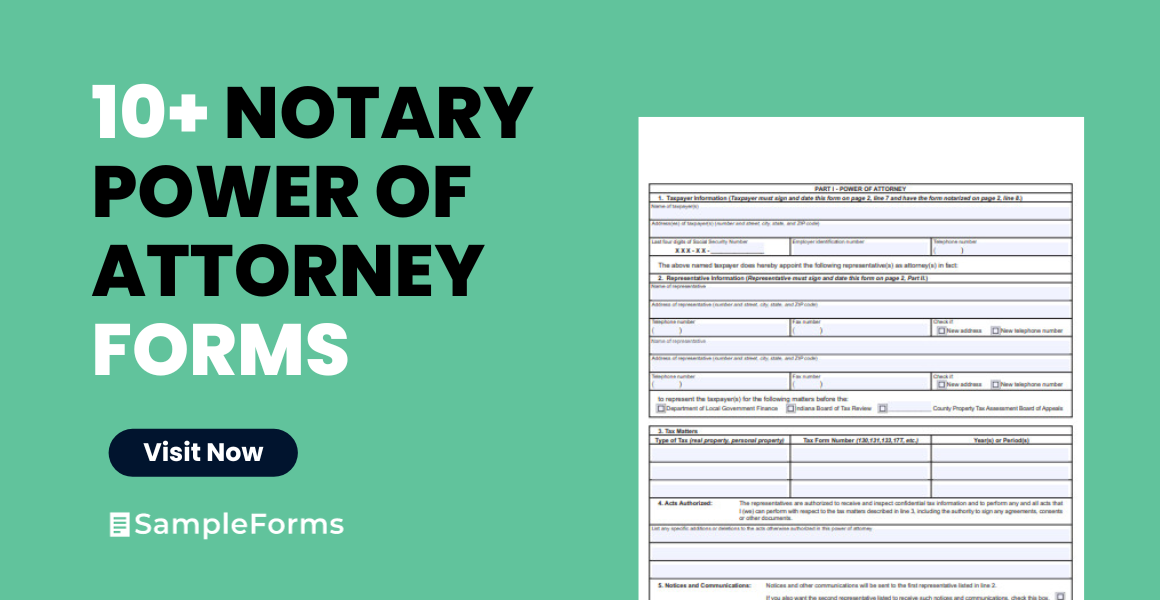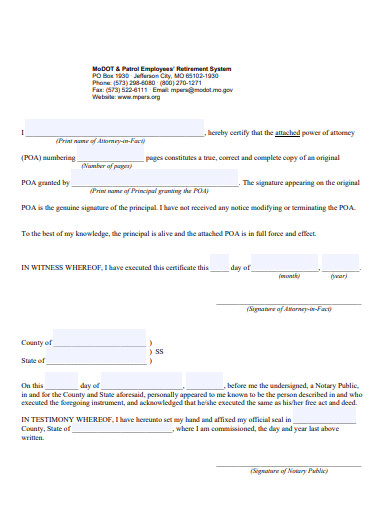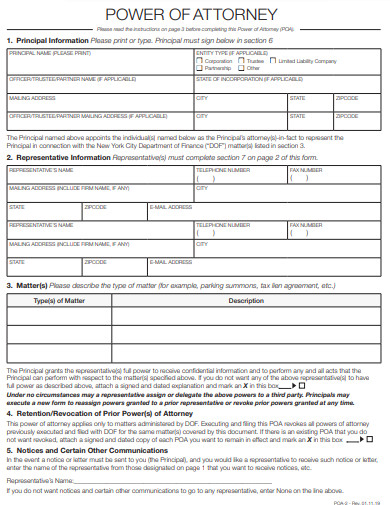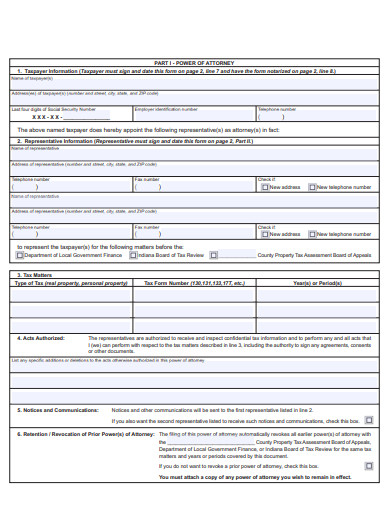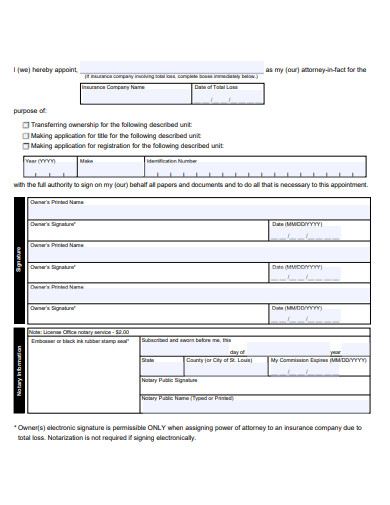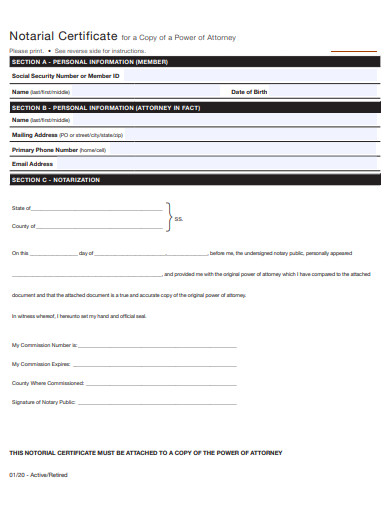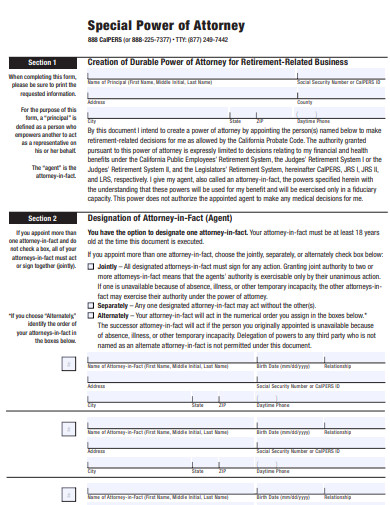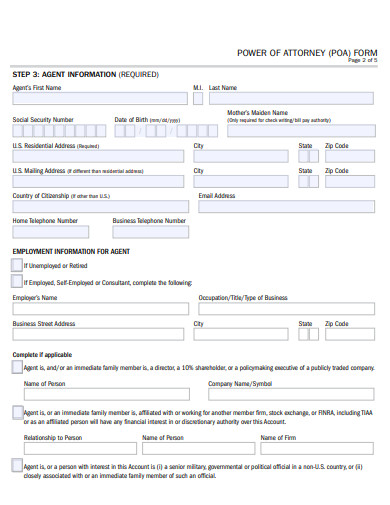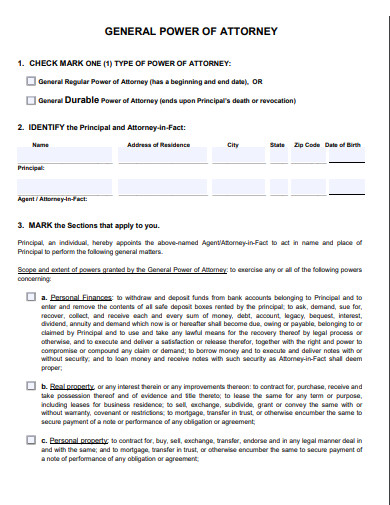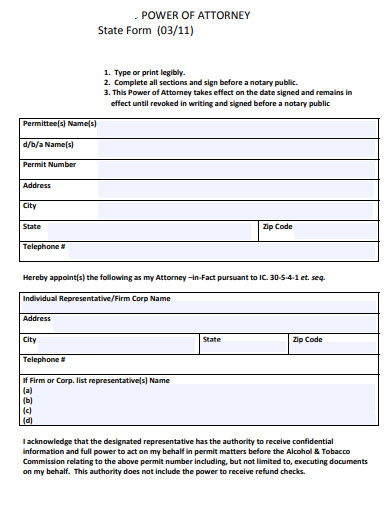Step into the realm of legal assurance with a Notary Power of Attorney Form—a critical document that undergoes notarization to affirm its authenticity. This form, pivotal in delegating decision-making power, comes in various types to fit unique scenarios, from financial to healthcare. Through this guide, we unlock the meaning behind each type, offer real-life examples, and provide a stepwise creation process complemented by expert tips, ensuring your document stands firm with indisputable legal credibility.
What is the Notary Power of Attorney Form ? – Definition
A Notary Power of Attorney Form is a legal document that grants one individual (the principal) the authority to appoint another person (the agent or attorney-in-fact) to make decisions and take actions on their behalf. The notary aspect indicates that the form has been notarized, which means it has been officially certified by a notary public. This certification confirms the identity of the signatories and adds a layer of verification, making the document recognized and trusted by financial institutions, government agencies, and courts.
What is the Meaning of the Notary Power of Attorney Form?
The meaning of a Notary Power of Attorney Form lies in its function as a legally binding document that not only delegates authority from one person to another but also carries the official assurance of a notary public. The notarization process verifies the identity of the signatories and their understanding and willingness to sign, thereby providing an added level of legal authenticity and integrity to the best form document. It is a testament to the document’s validity, used widely to manage affairs with confidence and security.
What is the best Sample Notary Power of Attorney Form?
Creating the best sample Notary Power of Attorney Form involves incorporating all the necessary elements to ensure it is comprehensive, clear, and legally enforceable. Here is a step-by-step guide to what this form should include:
Step 1: Title and Introduction
Begin with a title that clearly identifies the document as a Power of Attorney. Include an introductory statement that specifies the purpose of the document.
Step 2: Principal’s Information
Include a section for the principal to provide their full legal name, address, and other identifying details.
Step 3: Agent’s Information
Add a section for the agent’s full legal name, address, and contact information.
Step 4: Grant of Authority
Detail the specific powers granted to the agent, ensuring clarity about the scope and limitations of their authority.
Step 5: Durability Clause
Insert a clause that indicates whether the POA is durable, meaning it remains in effect if the principal becomes incapacitated.
Step 6: Execution Date
Provide a space for indicating the date the POA is executed.
Step 7: Signature Blocks
Create designated areas for the principal and agent to sign and date the document.
Step 8: Notary Acknowledgement
Include a notary section with appropriate space for the notary public’s signature, seal, and the date of notarization.
Step 9: Witness Signatures
If required by law, add lines for witness signatures, with spaces for their printed names and addresses.
Step 10: Instructions for Use
Provide clear instructions on how the POA should be used and any restrictions on its use.
Step 11: Contact Information
Include contact information for the principal and agent for any necessary follow-up.
This sample provides a framework for a Notary Power of Attorney Form sample. It’s important to adapt it to the laws of the specific jurisdiction where it will be used, and it’s recommended to seek legal advice to ensure the form meets all legal requirements.
1. Notary Power of Attorney Form
2. Texas Notary Power of Attorney Form
3. Vehicle Notary Power of Attorney Form
4. California Notary Power of Attorney Form
5. Copy Certification for Notary Power of Attorney Form
6. Notary Special Power of Attorney Form
7. Notary Limited Power of Attorney Form
8. Notary Public Power of Attorney Form
9. General Notary Power of Attorney Form
10. Notary Power of Attorney Format
11. Simple Notary Power of Attorney Form
What is the primary purpose of a Notary Power of Attorney Form?
The primary purpose of a Notary Power of Attorney Form is to create a legally recognized document where one person (the principal) appoints another (the agent or attorney-in-fact) to act on their behalf in specified matters. Notarization by a notary public formally certifies the identity of the parties and their signatures, providing an official and legal validation that the document is authentic and the signatories have willingly entered into the agreement. This notarization is often required for these printable form to be accepted by financial institutions, government entities, and in legal transactions.
How should I fill out a Notary Power of Attorney Form correctly?
Filling out a Notary Power of Attorney Form correctly involves several important steps:
- Identify the Parties: Clearly print the full legal names and addresses of the principal and the agent.
- Define the Scope: Specify the powers being granted, whether general or limited to certain acts.
- Determine the Duration: Indicate when the powers will commence and if they will expire.
- Add a Durability Clause: If desired, state that the powers will continue if the principal becomes incapacitated.
- Sign in the Presence of Witnesses: Execute the form in the presence of the required number of witnesses, depending on local laws.
- Complete the Notarization: Sign the form in front of a notary public who will verify your identity and apply their seal, making the document legally recognized.
- Keep Copies: After notarization, make copies for your records and provide one to your agent.
- Seek Legal Advice: Consult a legal professional to ensure the form meets all requirements and truly reflects your intentions.
- Follow State Laws: Ensure all state-specific legal requirements are met, as POA laws can vary by jurisdiction.
Where do I submit a completed Notary Power of Attorney Form?
A completed Notary Power of Attorney (POA) Form doesn’t usually need to be submitted to a specific government agency; instead, it should be kept securely and made accessible when needed. Here’s what you typically do with it:
- Provide to the Agent: Give a notarized copy to the person you’ve designated as your agent.
- Inform Financial Institutions: If the POA includes financial decisions, provide a copy to banks and financial organizations involved.
- Notify Healthcare Providers: For healthcare-related POAs, inform your doctors and healthcare facilities.
- Real Estate Transactions: If applicable, a copy may need to be recorded with the county recorder’s office for real estate matters.
- Legal and Tax Matters: Tax authorities and legal entities should receive copies if the agent will handle these areas.
- Safe Storage: Keep the original document in a secure place, like a safe deposit box, and let the agent know where it is.
- Third Parties: Any other parties who may be affected by the POA should be informed or provided with copies as necessary.
Remember to check the requirements in your jurisdiction as some places may have additional rules regarding the filing or recording of POA forms. You also browse our Simple Power of Attorney Forms.
What is the process for revoking a Notary Power of Attorney Form?
Revoking a Notary Power of Attorney (POA) Form involves a few key steps:
- Draft a Revocation Document: Create a written document stating your intention to revoke the POA. Include your name, the date of the original POA, and the name of the agent.
- Notarize the Revocation: Sign the revocation document in front of a notary public to validate the revocation.
- Notify the Agent: Provide your agent with a copy of the notarized revocation notice.
- Inform Third Parties: Notify any institutions or individuals that may be affected by the revocation, such as banks, healthcare providers, and legal entities.
- Retrieve Copies: Attempt to collect and destroy all copies of the original POA to prevent future use.
- Record the Revocation: If the original POA was recorded with any government office (e.g., for real estate transactions), record the revocation in the same office.
- Legal Consultation: Consider seeking legal advice to ensure the revocation is thorough and complies with local laws.
- Follow-Up: Monitor to ensure that the revocation is acknowledged and that the agent ceases all actions under the revoked POA.
Do I need a lawyer to draft a Notary Power of Attorney Form?
While it is not legally required to have a lawyer to draft a Notary Power of Attorney Form, consulting with a lawyer is highly recommended, especially if the matters are complex. A lawyer can provide legal advice, ensure that the document meets all legal requirements in your jurisdiction, and tailor these fillable form to your specific circumstances and needs. Legal counsel can also help avoid any potential issues that could affect the document’s validity or enforceability.
What are the limitations of a Notary Power of Attorney Form?
The limitations of a Notary Power of Attorney Form include:
- Scope of Authority: The agent can only perform actions as specified in the form; anything not explicitly granted is beyond their power.
- Jurisdiction: The form is subject to state or country laws, and powers may not be recognized across different jurisdictions.
- Duration: Unless it’s durable, the POA may not remain valid if the principal becomes incapacitated.
- Revocation: The POA remains in effect until it is formally revoked, which requires specific actions from the principal.
- Third-Party Acceptance: Some institutions may require their own forms or may be hesitant to accept any POA.
- Agent’s Limitations: The agent must act in the principal’s best interests and within the bounds of the law; personal benefit from the POA is generally prohibited.
- No Estate Powers: The POA does not grant the agent authority to act as an executor of a will unless specifically stated.
- Non-Transferability: The appointed agent cannot transfer their authority to someone else unless the POA explicitly allows delegation.
- Not a Will Substitute: The POA does not serve as a will and cannot distribute assets upon death.
How to Create the Notary Power of Attorney Form? – a Step by Step Guide
Tips for creating an Effective Notary Power of Attorney Form
To create an effective Notary Power of Attorney (POA) Form, consider the following tips:
- Be Specific: Clearly define the scope and limits of the powers you are granting to prevent misuse and confusion.
- Choose Wisely: Select an agent who is trustworthy, willing, and capable of handling the responsibilities you’re delegating.
- Consider Durability: Decide if the POA should be durable, remaining effective if you become incapacitated.
- Legal Compliance: Ensure the form complies with state or national laws to guarantee its validity.
- Notarization: Include clear instructions on the notarization process and make sure it meets legal requirements for notarized documents.
- Review Regularly: Keep your POA updated with any changes in your life circumstances or legal requirements.
- Multiple Copies: After notarization, make several copies of the POA for your records, your agent, and any institutions that may require it.
- Revocation Terms: Outline the process for revoking the POA should the need arise.
- Witness Requirements: Understand the witness requirements in your jurisdiction and adhere to them strictly.
- Seek Legal Advice: It’s advisable to consult with a legal professional to ensure the document is correctly drafted and executed.
A Notary Power of Attorney Form is a legal directive, notarized to confirm authenticity, that delegates authority to an agent for specific or broad actions. Various types cater to distinct needs. This guide has walked you through creation, with examples and tips to ensure effectiveness, stressing the importance of precision, legal adherence, and the notarization process for an unquestionably valid and functional document. You may also be interested to browse through our other Special Power of Attorney Forms and Printable Power of Attorney Forms.
Related Posts
-
10+ Free New Hampshire (NH) Power of Attorney Form Download – How to Create Guide, Tips
-
10+ Free Nevada (NV) Power of Attorney Form Download – How to Create Guide, Tips
-
10+ Free Nebraska (NE) Power of Attorney Form Download – How to Create Guide, Tips
-
10+ Free Montana (MT) Power of Attorney Form Download – How to Create Guide, Tips
-
10+ Free Missouri (MO) Power of Attorney Form Download – How to Create Guide, Tips
-
10+ Free Minnesota (MN) Power of Attorney Form Download – How to Create Guide, Tips
-
10+ Free Mississippi (MS) Power of Attorney Form Download – How to Create Guide, Tips
-
10+ Free Massachusetts (MA) Power of Attorney Form Download – How to Create Guide, Tips
-
10+ Free Maryland (MD) Power of Attorney Form Download – How to Create Guide, Tips
-
10+ Free Maine (ME) Power of Attorney Form Download – How to Create Guide, Tips
-
10+ Free Louisiana (LA) Power of Attorney Form Download – How to Create Guide, Tips
-
10+ Free Kentucky (KY) Power of Attorney Form Download – How to Create Guide, Tips
-
10+ Free Kansas (KS) Power of Attorney Form Download – How to Create Guide, Tips
-
10+ Free Iowa (IA) Power of Attorney Form Download – How to Create Guide, Tips
-
10+ Free Indiana (IN) Power of Attorney Form Download – How to Create Guide, Tips
